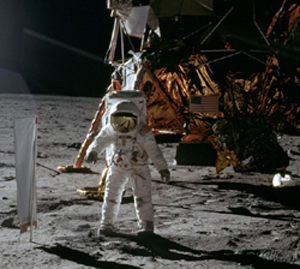NASA celebrates 45 years of moon landing
Mangalore Today News Network
Washington, July 21, 2014, (IANS): In this July 20, 1969 file photo provided by NASA, astronaut Edwin E. Aldrin Jr. walks on the surface of the moon, with seismogaphic equipment that he just set up. The flag like object on a pole is a solar wind experiment and in the background is the Lunar Landing Module. (AP Photo) On July 20, 1969, Apollo 11 astronauts Neil Armstrong and Buzz Aldrin became the first humans to set foot on the moon.
On July 20, 1969, Apollo 11 astronauts Neil Armstrong and Buzz Aldrin became the first humans to set foot on the moon.
Forty-five years later, NASA will celebrate Monday the giant leap by honouring Armstrong, who died in 2012, with a renaming ceremony of the historic "operations and checkout building" at Cape Canaveral in Florida, the launch site.
Both Aldrin and Michael Collins, the Apollo 11 command module pilot who orbited the moon, will be there.
"It was 45 years ago that Neil Armstrong took the small step onto the surface of the moon that changed the course of history. The years that followed saw a space age of scientific, technological and human research on which we have built the modern era," NASA said in a statement.
The Apollo missions blazed a path for human exploration to the moon and today, we are extending that path to near-Earth asteroids, Mars and beyond, it added.
To send humans to deep space, NASA engineers are developing a new space transportation capability destined to travel far beyond Earth.
The Orion spacecraft and Space Launch System (SLS) heavy-lift rocket will be the most advanced space vehicles ever built.
"Around 2019, we will launch a robotic mission to rendezvous with a near-Earth asteroid. The spacecraft will either capture an asteroid or retrieve a boulder off of a much larger asteroid and then redirect the asteroid mass to a stable orbit around the moon," the US apace agency said.
In the mid 2020s, astronauts aboard the Orion spacecraft, launched by SLS, will explore that asteroid and return to Earth with samples.
In December 2014, NASA is set to conduct the first test flight of Orion.
In 2015, the "New Horizons" mission will fly by Pluto and see the icy world up close for the first time.
"In 2020, we will send a new rover to Mars, to follow in the footsteps of Curiosity, search for evidence of life and pave the way for future human explorers," NASA announced.
- Mangaluru: Yellow alert issued as thunderstorms expected across coastal Karnataka
- Mangaluru: Bride-to-be goes missing a day before wedding in Bolar
- Puttur: Grand Brahmarathotsav at Shri Mahalingeshwara Temple draws thousands with devotion and splendor
- Karnataka HC raps state over protest against Waqf Act amid pending SC case
- Fisheries Ministry to launch data collection across the country for Marine Fishers Census from November
- Elephant tries to sneak into house in Mudigere
- Holy Thursday celebrated with solemnity at Our Lady of Miracles Church, Milagres
- ABVP to launch ‘Save Mangalore University’ campaign
- MLA asks corporation to focus on landslip-prone areas and under-construction buildings ahead of Monsoon
- Mangaluru: Woman gang-raped near Netravati river, auto driver among three arrested
- Kukke Subrahmanya temple retains title as Karnataka’s richest temple with Rs 155.95 crore annual revenue
- Karnataka HC orders crackdown on clinics run by ’unqualified doctors’
- Karnataka relaxes age rule for class 1 admission to 5.5 Years for 2025-26 academic year
- Man who flashed woman, assaulted 7 people arrested in Bengaluru
- FIR against Sunny Deol, Randeep Hooda for offending Christian religious sentiments in Jaat
- 22 maoists surrender before security forces in Chhattisgarh’s Sukma
- Indian Embassy repatriates 4 nationals scammed in Myanmar’s Myawaddy
- ED debunks Bengaluru man’s claims of importing Rs 50-crore wolfdog
- Special cabinet meeting on caste census in Karnataka ends without any major decision
- High Court to hear Ranya Rao bail plea on April 21
- India slams Pakistan Army chief’s remarks: ‘Kashmir’s only relation with Pak is…’
- Removal of sacred thread at CET centre in Shivamogga triggers row
- JD Vance, wife Usha to visit India from April 21-24, hold talks with PM Modi
- 22 Naxalites arrested, explosives seized in Chhattisgarh
- CRPF ’backbone’ of mission to rid country of Naxalism by March 2026: Amit Shah
- Skills and Competencies Take Center Stage at MSN Dialogue Series
- Court remands Maoist Lakshmi to six-day police custody
- Sandhya Shenoy honored with Society for Materials Chemistry Medal-2024
- White Cornus Apartment in Mangaluru
- City girl wins first place in state-level spell bee competition
- Alleged ‘Love Jihad’ Case in Mangaluru: Woman left home voluntarily, says police
- Girl fatally struck by reckless two-wheeler near Belman
- New residential complex for the judges inaugurated in Mangaluru
- Absconding accused nabbed after 8 years
- Truck with cylinders turns turtle in Beltangady
- Bhoota Kola artist dies of cardiac arrest
- Development of the country should be our goal: Ganesh Karnik
- Container truck gets stuck under Modankap railway bridge
- Truck crushes bike’s pillion rider near BC Road
- Head constable dies of heart attack
- CITY INFORMATION
- TRAVEL
- TOURIST INFORMATION
- HEALTH CARE
- MISCELLANEOUS




 Write Comment
Write Comment E-Mail To a Friend
E-Mail To a Friend Facebook
Facebook Twitter
Twitter  Print
Print 


